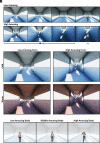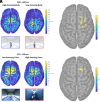Architectural experience influences the processing of others' body expressions
- PMID: 37782807
- PMCID: PMC10576150
- DOI: 10.1073/pnas.2302215120
Architectural experience influences the processing of others' body expressions
Abstract
The interplay between space and cognition is a crucial issue in Neuroscience leading to the development of multiple research fields. However, the relationship between architectural space and the movement of the inhabitants and their interactions has been too often neglected, failing to provide a unifying view of architecture's capacity to modulate social cognition broadly. We bridge this gap by requesting participants to judge avatars' emotional expression (high vs. low arousal) at the end of their promenade inside high- or low-arousing architectures. Stimuli were presented in virtual reality to ensure a dynamic, naturalistic experience. High-density electroencephalography (EEG) was recorded to assess the neural responses to the avatar's presentation. Observing highly aroused avatars increased Late Positive Potentials (LPP), in line with previous evidence. Strikingly, 250 ms before the occurrence of the LPP, P200 amplitude increased due to the experience of low-arousing architectures, reflecting an early greater attention during the processing of body expressions. In addition, participants stared longer at the avatar's head and judged the observed posture as more arousing. Source localization highlighted a contribution of the dorsal premotor cortex to both P200 and LPP. In conclusion, the immersive and dynamic architectural experience modulates human social cognition. In addition, the motor system plays a role in processing architecture and body expressions suggesting that the space and social cognition interplay is rooted in overlapping neural substrates. This study demonstrates that the manipulation of mere architectural space is sufficient to influence human social cognition.
Keywords: EEG; architectural cognition; emotional body expressions; premotor cortex; virtual reality.
Conflict of interest statement
The authors declare no competing interest.
Figures




Similar articles
-
Decoding subjective emotional arousal from EEG during an immersive virtual reality experience.Elife. 2021 Oct 28;10:e64812. doi: 10.7554/eLife.64812. Elife. 2021. PMID: 34708689 Free PMC article.
-
The effect of arousal on regulation of negative emotions using cognitive reappraisal: An ERP study.Int J Psychophysiol. 2017 Aug;118:18-26. doi: 10.1016/j.ijpsycho.2017.05.012. Epub 2017 Jun 1. Int J Psychophysiol. 2017. PMID: 28579154
-
Experimental results of affective valence and arousal to avatar's facial expressions.Cyberpsychol Behav. 2005 Oct;8(5):493-503. doi: 10.1089/cpb.2005.8.493. Cyberpsychol Behav. 2005. PMID: 16232042
-
Significance?& Significance! Empirical, methodological, and theoretical connections between the late positive potential and P300 as neural responses to stimulus significance: An integrative review.Psychophysiology. 2020 Jul;57(7):e13570. doi: 10.1111/psyp.13570. Epub 2020 Apr 3. Psychophysiology. 2020. PMID: 32243623 Review.
-
Attention and emotion: An integrative review of emotional face processing as a function of attention.Cortex. 2020 Sep;130:362-386. doi: 10.1016/j.cortex.2020.06.010. Epub 2020 Jul 6. Cortex. 2020. PMID: 32745728 Review.
Cited by
-
Voice attractiveness affects cooperative behavior in the Stag Hunt Game: evidence from neural electrophysiology.Front Neurosci. 2025 Mar 28;19:1576757. doi: 10.3389/fnins.2025.1576757. eCollection 2025. Front Neurosci. 2025. PMID: 40224644 Free PMC article.
References
-
- Dorfman A., Weiss O., Hagbi Z., Levi A., Eilam D., Social spatial cognition. Neurosci. Biobehav. Rev. 121, 277–290 (2021). - PubMed
-
- Sternberg E. M., Wilson M. A., Neuroscience and architecture: Seeking common ground. Cell 127, 239–242 (2006). - PubMed
-
- Eberhard J. P., Applying neuroscience to architecture. Neuron 62, 753–756 (2009). - PubMed
Publication types
MeSH terms
LinkOut - more resources
Full Text Sources
Miscellaneous

